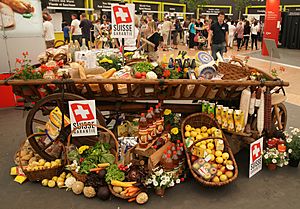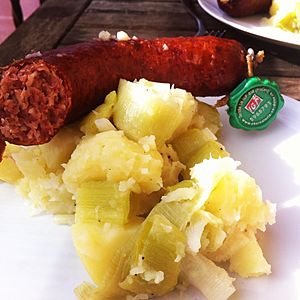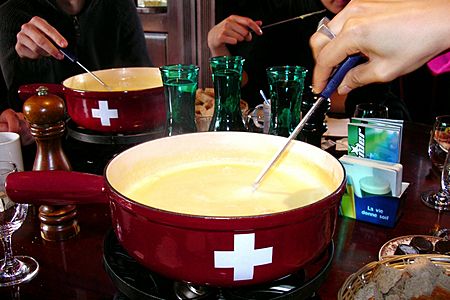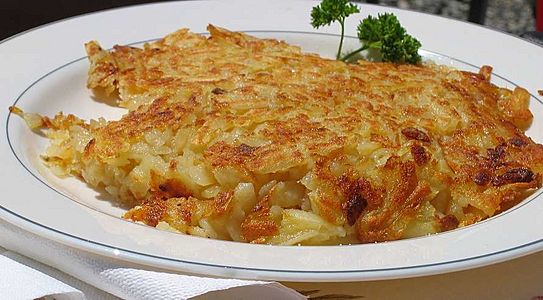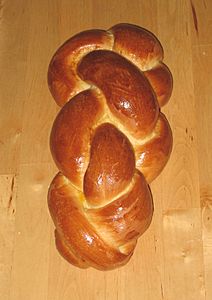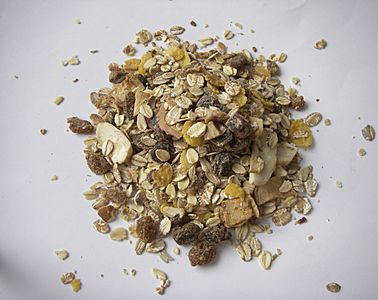Swiss cuisine facts for kids
Swiss food is a mix of flavors from France, Germany, and Northern Italy. This is because Switzerland has always been a country with lots of farms. So, many traditional Swiss dishes are simple and use basic ingredients like potatoes and Swiss cheese. Switzerland has many different cultures, and this shows in the huge number of special foods from different regions.
Some famous Swiss dishes are raclette and fondue (melted cheese eaten with bread or potatoes), rösti (fried grated potatoes), muesli (a breakfast dish with oats), and Zürcher Geschnetzeltes (veal and mushrooms in a creamy sauce).
Contents
Swiss Food and Dishes
Switzerland has many special dishes from different areas. For example, Zürcher Geschnetzeltes is a dish with thin strips of veal and mushrooms in a creamy sauce. It is often served with rösti. Italian food like pasta and pizza is also very popular in Switzerland today.
Foods often linked with Switzerland are special kinds of cheese and milk chocolate. Swiss cheeses like Emmental, Gruyère, Vacherin, and Appenzeller are famous around the world. The most popular cheese dishes are fondue and raclette. These dishes started in certain regions but became popular everywhere thanks to the Swiss Cheese Union, which helped sell more cheese.
Rösti is a popular potato dish eaten all over Switzerland. It was first a breakfast food. Now, muesli is more common for breakfast. In Switzerland, muesli is often called "Birchermüesli." For breakfast and dinner, many Swiss people enjoy sliced bread with butter and jam. There are many kinds of bread rolls in Switzerland. Bread and cheese is a favorite simple dinner.
Tarts and quiches are also traditional Swiss foods. Tarts are made with many different toppings, from sweet apple to onion.
In the Italian-speaking part of Switzerland, called Ticino, you can find unique restaurants called Grottoes. These are simple places that serve traditional food, from pasta to homemade meat dishes. Popular foods include Luganighe and Luganighetta, which are types of artisan sausages. Real grottoes used to be old wine caves that were turned into restaurants. They are often found in or near forests, built against rocky hills. Grottoes are popular with both locals and tourists, especially in the warm summer months.
Recipes from French-Speaking Switzerland
- Carac: A Swiss chocolate pastry with a shortcrust base.
- Fondue: Melted cheese served in a pot. Small pieces of bread or potatoes are dipped into it.
- Malakoff: Fried cheese balls or sticks from the canton of Vaud.
- Meringue: Swiss Meringue served with rich double cream from Gruyère.
- Papet vaudois: This filling dish from the canton of Vaud has leeks and potatoes. It is usually served with Saucisse au chou (cabbage sausage).
- Raclette: Hot cheese scraped over potatoes. It is served with small gherkins and pickled onions.
-
Dipping a cheese fondue with a long-stemmed fork
Recipes from Swiss-German Speaking Switzerland
- Älplermagronen (Alpine herdsman's macaroni): This dish uses simple ingredients that herdsmen had in their mountain homes: macaroni, potatoes, onions, bacon, and melted cheese. It is often served with applesauce.
- Zürcher Geschnetzeltes: This dish has sliced strips of veal in a creamy white wine sauce. It is often served with Rösti.
- Basler Läckerli: A traditional hard biscuit from Basel, made with honey, almonds, candied fruit, and spices.
- Bündner Nusstorte: A famous nut cake, especially from the Engadine valley in Graubünden.
- Emmental Apple Rösti: Made from old bread, apple, and sugar. This sweet dish used to be popular for using up leftovers. It comes from the Emmental valley in the canton of Bern, where Emmentaler cheese is made.
- Landjäger: A semi-dried sausage from Switzerland. It is a popular snack for hiking because it does not need to be refrigerated. It tastes like dried salami.
- Bircher muesli: This healthy breakfast was invented by Dr. Maximilian Oskar Bircher-Benner (1867-1939), who was a pioneer in healthy eating.
- Riz Casimir: This dish has rice with curry sauce and minced pork mixed with tropical fruits like pineapple, banana, and cherries. It was first served in 1952 by the Mövenpick hotel chain.
- Rösti: This simple potato dish is similar to hash browns. It is a favorite in German-speaking Switzerland.
- Tirggel (ZH): These are traditional Christmas biscuits from Zurich. They are thin, hard, and sweet, made from flour and honey.
- Zopf (bread): There are many kinds of bread in Switzerland. Zopf is a special braided bread often eaten on Sundays.
- Zuger Kirschtorte (ZG): A famous cake from Zug, made with layers of sponge cake, buttercream, and cherry liqueur.
Recipes from Italian-Speaking Switzerland
- Polenta: For many years, polenta was seen as food for poor people. Corn came to the south of what is now the canton of Ticino in the 1600s. It took 200 more years for polenta to become the main dish there.
- Saffron Risotto: This is a common dish from Ticino, the southernmost canton of Switzerland.
- Pizzoccheri: A type of pasta dish, often made with buckwheat pasta, vegetables, and cheese.
Recipes from the Canton of Graubünden
- Bündner Nusstorte: There are different recipes for nut cake, but the most famous is from the Engadine, a valley in Graubünden.
- Bündner Barley Soup: This is the most famous soup from Graubünden.
- Capuns: A special dish from western Graubünden, often made with dough wrapped in chard leaves.
- Maluns: Another typical dish from Graubünden, made from grated potatoes.
-
Various dried meat dishes from the canton of Grisons, Switzerland – dried beef, coppa, prosciutto and cooked ham
Fine Dining in Switzerland
In 2005, Switzerland was ranked second in the world for the number of Michelin stars per person. This means many restaurants in Switzerland offer very high-quality, fancy meals.
Swiss Drinks
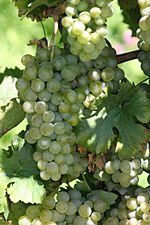
Rivella, a fizzy Swiss drink made from lactose (milk sugar), is one of the most popular drinks in Switzerland. Apple juice, both still and sparkling, is also popular. It is also made into apple cider. The chocolate drink Ovomaltine (known as "Ovaltine" in the USA) started in Switzerland and is still very popular, especially with young people. You can drink it, or even sprinkle the powder on buttered bread.
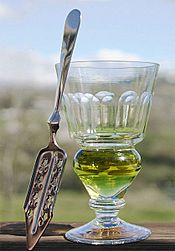
Wine is made in many parts of Switzerland, especially in Valais, Vaud, Ticino, Neuchâtel, and the canton of Zurich. Riesling X Sylvaner is a common white wine in the German-speaking areas. Chasselas is the most common white wine in French-speaking parts. Pinot noir is the most popular red grape in both French and German-speaking areas, while Merlot is most popular in the Italian-speaking part.
Absinthe is now officially made again in its birthplace, Val-de-Travers, in the Jura region of Switzerland. It was banned for a long time but became legal again in 2005. Now, Swiss absinthe is sold to many countries. In Switzerland, people aged 16 or older can buy wine and beer. For stronger drinks like spirits, you must be 18 or older.
Damassine is a liqueur made from the Damassine prune fruit. It is produced in the canton of Jura. Bon Pere William is a famous Swiss brandy made from pears. It is often served with fondue or raclette, or after dinner. Sometimes, a whole pear is grown inside the bottle! Many other regional brandies are made from local fruits, like cherries (kirschwasser).
Switzerland has one of the highest coffee consumptions per person in the world.
See also
 In Spanish: Gastronomía de Suiza para niños
In Spanish: Gastronomía de Suiza para niños


